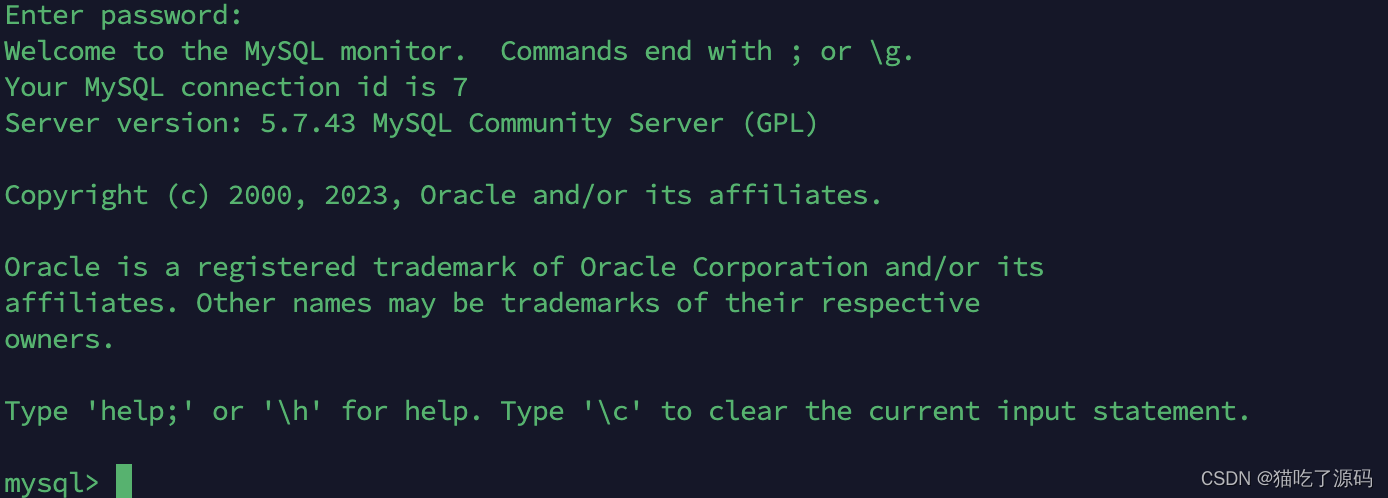目录
一、序
MySQL5.7是我们平时常用的Web数据库之一,Linux下安装和卸载可能会遇到不少坑,本文以Centos7下安装和卸载社区版MySQL5.7为例,详细记录了安装和卸载过程,方便大家参考,喜欢的可以点赞收藏,关注咱不迷路。
| 操作系统 | MySQL |
| Centos7.9 | MySQL5.7社区版 |
注意:确保以root用户身份登录系统安装
二、MySQL安装详细步骤
更新软件包
yum update -y检查是否安装过MySQL
rpm -qa | grep -i mysql如果发现已经安装过,可参考第四部分的MySQL卸载
下载Yum源配置文件
# noarch表示该软件包不依赖特定Linux发行版
wget https://dev.mysql.com/get/mysql57-community-release-el7-11.noarch.rpm安装Yum源配置文件
执行安装命令
rpm -ivh mysql57-community-release-el7-11.noarch.rpm缺省会在/etc/yum.repos.d目录下生成两个配置文件

安装MySQL服务器
yum -y install mysql-community-server默认会安装以下5个rpm包

注意:此处可能安装失败,提示Public key for mysql-community-common-5.7.43-1.el7.x86_64.rpm is not installed异常信息:

问题原因:MySQL秘钥过期导致
解决方法:导入新的秘钥信息
rpm --import https://repo.mysql.com/RPM-GPG-KEY-mysql-2022重新执行安装,出现如下信息表示安装成功

启动MySQL服务器
systemctl start mysqld查看MySQL状态
systemctl status mysqldactive (running)表示已经启动成功正在运行
查看MySQL版本
mysql -V执行结果

获取临时密码
grep "password" /var/log/mysqld.log执行结果
![]()
设置root密码
首次登录可使用如下两种方式设置root密码:
运行安全脚本(生产环境推荐)
执行安全脚本,加固MySQL安全性,设置新的root密码
mysql_secure_installation输入临时root密码

设置新的root密码,缺省安全策略是MEDIUM,要求至少包含8个字符,其中至少有一个大小写字母,一个特殊字符,一个数字,否则报 ... Failed! Error: Your password does not satisfy the current policy requirements异常。

输入要求的密码后可继续如下配置
Estimated strength of the password: 100
Do you wish to continue with the password provided?(Press y|Y for Yes, any other key for No) : y
By default, a MySQL installation has an anonymous user,
allowing anyone to log into MySQL without having to have
a user account created for them. This is intended only for
testing, and to make the installation go a bit smoother.
You should remove them before moving into a production
environment.
# 移除匿名用户
Remove anonymous users? (Press y|Y for Yes, any other key for No) : y
Success.
Normally, root should only be allowed to connect from
'localhost'. This ensures that someone cannot guess at
the root password from the network.
# 禁用远程root登录
Disallow root login remotely? (Press y|Y for Yes, any other key for No) : y
Success.
By default, MySQL comes with a database named 'test' that
anyone can access. This is also intended only for testing,
and should be removed before moving into a production
environment.
# 删除测试数据库及权限
Remove test database and access to it? (Press y|Y for Yes, any other key for No) : y
- Dropping test database...
Success.
- Removing privileges on test database...
Success.
Reloading the privilege tables will ensure that all changes
made so far will take effect immediately.
# 重新加载授权表
Reload privilege tables now? (Press y|Y for Yes, any other key for No) : y
Success.
All done! 修改安全策略
执行登录
mysql -uroot -p输入临时密码,进入MySQL

修改安全策略,使用简单密码登录
# 查看当前安全策略
show variables like 'validate_password%';
# 最低安全策略(0->LOW ,1->MEDIUM, 2->STRONG)
set global validate_password_policy=0;
# 最小密码字符长度是4
set global validate_password_length=4;
# 设置本机root密码
alter user 'root'@'localhost' identified by 'root';设置成功后,输入quit命令使用修改后的密码重新登录,该方法只是临时生效重启MySQL后会失效,如果需要永久生效,需要修改/etc/my.conf重启MySQL服务。
设置开机启动
systemctl enable mysqld停止MySQL服务器
systemctl stop mysqld三、MySQL使用示例
远程访问
登录本机,针对root用户赋权和设置密码
# 授权,all表示所有ddl和dml操作权限,*.*表示针对所有数据库所有表,%表示本机和远程主机均能访问
grant all privileges on *.* to 'root'@'%' identified by '123456' with grant option;
# 刷新权限
flush privileges;
关闭本机防火墙
systemctl stop firewalld通过远程主机执行,输入密码即可访问
mysql -h 192.168.5.11 -uroot -p结果

四、MySQL卸载详细步骤
停止MySQL服务
卸载MySQL之前,首先需要停止MySQL服务
systemctl stop mysqld卸载MySQL软件包
yum -y remove mysql-server mysql-client mysql-common mysql-libs结果如下表示卸载完毕

删除MySQL数据文件和配置文件
MySQL的数据文件和配置文件通常位于 /var/lib/mysql 和 /etc/my.cnf,执行删除命令
rm -rf /var/lib/mysql
rm -rf /etc/my.cnf卸载Yum源配置文件
rpm -e mysql57-community-release-el7-11.noarch清理MySQL用户和组
userdel mysql
groupdel mysql清理MySQL日志文件和临时文件
rm -rf /var/log/mysql
rm -rf /tmp/mysql*